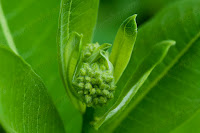 Walking along a lake today, we smelled grapes. Grapes? In August? You bet, and I picked 4 gallons of them, purplish-black, large, and yeasty smelling. We came home and made 2 batches of jam immediately. This season is so early, since we do not usually see grapes until late September or early October around here.
Walking along a lake today, we smelled grapes. Grapes? In August? You bet, and I picked 4 gallons of them, purplish-black, large, and yeasty smelling. We came home and made 2 batches of jam immediately. This season is so early, since we do not usually see grapes until late September or early October around here.
Another super early fruit is the autumn olive. There is great variability between bushes, almost like they each have their own personality. Ripening times and taste vary between bushes, even ones right next to each other. We have managed to pick enough already for one batch of jam and some fruit leather. Today we introduced the bush to someone who was chatting with us while we picked grapes, and then we gave him his own bag to gather some. The fully ripe and sweet bush was right alongside many totally green-berried bushes.
 Robert manged to grab 3 very large puffball mushrooms, and we are going to try to have them confirmed by David Fischer. We have his book "Edible Wild Mushrooms of North America" and he will personally answer emails about mushrooms. We upload pictures and spore print photos to him, and find his website very useful http://americanmushrooms.com/
Robert manged to grab 3 very large puffball mushrooms, and we are going to try to have them confirmed by David Fischer. We have his book "Edible Wild Mushrooms of North America" and he will personally answer emails about mushrooms. We upload pictures and spore print photos to him, and find his website very useful http://americanmushrooms.com/
 Robert went out to pick some more elderberries for another batch of elderberry-sumac jam made with sumac juice. Smooth sumac is wonderfully acidic, and easy to spot with it's bright red berries. The color of the sumac-ade is not quite as red with the smooth sumac as with the staghorn sumac, it is a bit more orange. We always have a container of the sumac-ade chilling in the fridge. Robert also tried a jelly made from the sumac with a sassafras infusion. The result is a amber colored, spicy, tart jelly that he and Gillian love.
Robert went out to pick some more elderberries for another batch of elderberry-sumac jam made with sumac juice. Smooth sumac is wonderfully acidic, and easy to spot with it's bright red berries. The color of the sumac-ade is not quite as red with the smooth sumac as with the staghorn sumac, it is a bit more orange. We always have a container of the sumac-ade chilling in the fridge. Robert also tried a jelly made from the sumac with a sassafras infusion. The result is a amber colored, spicy, tart jelly that he and Gillian love. We also went out this past week to pick beach plums(Prunus maritima). We got 3 gallons, and made 35 jars of reddish-purple, pulpy jam filled with the tart skins. This is a very tasty jam, perhaps my new favorite flavor. There were lots of the small plums left over, so we made a black cherry-plum wine.
 A few more edibles we noticed were spicebushes, with their bright red, peppery berries, and wintergreen. Spicebush (Lindera benzoin) berries taste like tart allspice, and can be chopped and ground and added to recipes. The twigs and leaves can be gathered fresh for teas. Wintergreen (Gaultheria procumbens) berries are high in vitamin C and make a great breath refresher. The leaves can be used fresh or dried for an invigorating tea. Wintergreen contains methyl salicylate, which is a compound related to the active ingredient in aspirin, so chewing the berries or drinking the tea can help with minor pain.
A few more edibles we noticed were spicebushes, with their bright red, peppery berries, and wintergreen. Spicebush (Lindera benzoin) berries taste like tart allspice, and can be chopped and ground and added to recipes. The twigs and leaves can be gathered fresh for teas. Wintergreen (Gaultheria procumbens) berries are high in vitamin C and make a great breath refresher. The leaves can be used fresh or dried for an invigorating tea. Wintergreen contains methyl salicylate, which is a compound related to the active ingredient in aspirin, so chewing the berries or drinking the tea can help with minor pain.

















